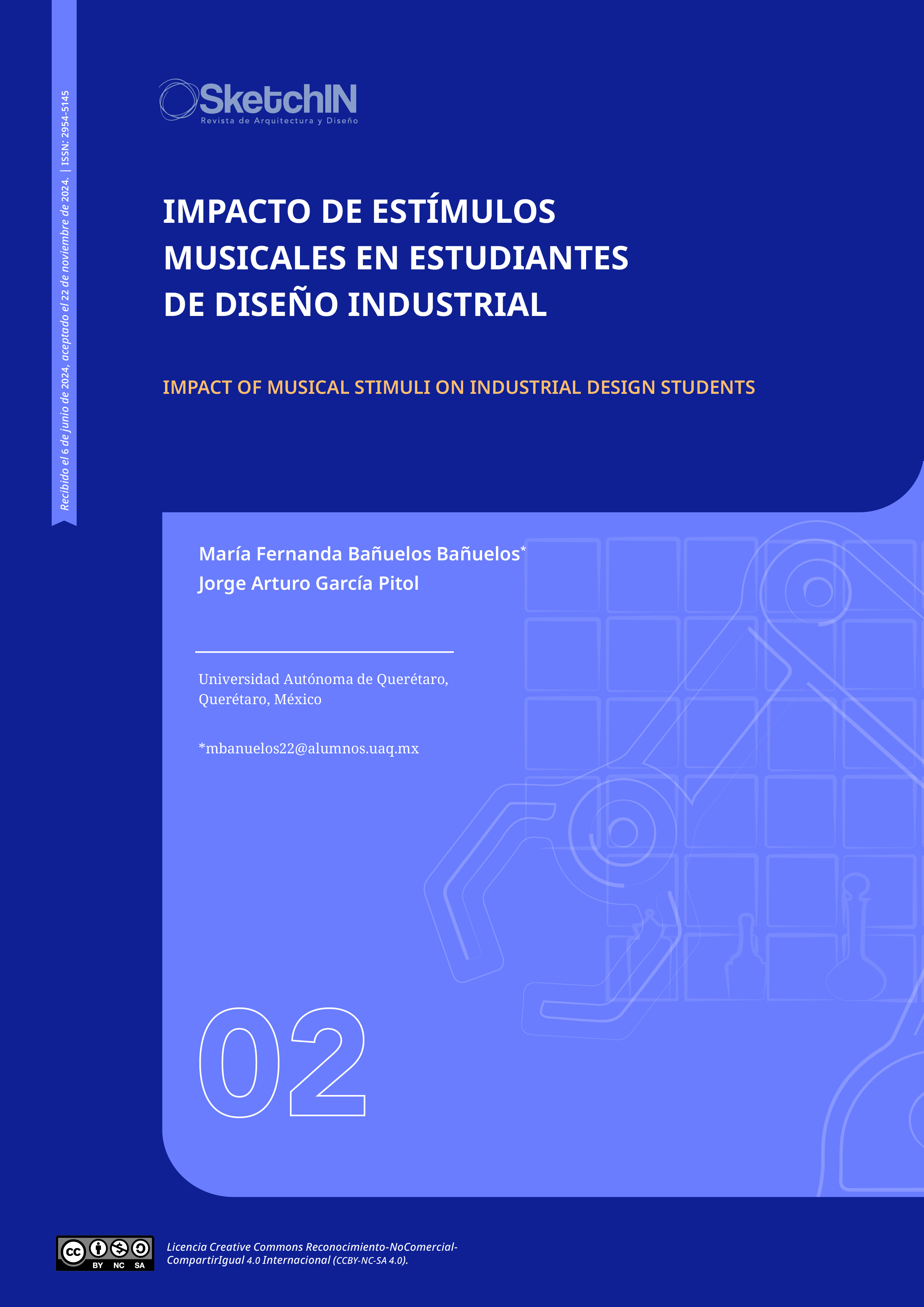Abstract
The study techniques that are usually applied in classes are not favorable for students with attention deficit. Although there are several proposals with strategies to concentrate attention, these have not been proved with college students yet. Researchers such as Jurado Noboa (2018), Soto (2009) and Griffiths (2001) indicate that musical stimulation can help maintain concentration. On another note, Velasquez et al. (2009) point out how neuronal connections are triggered by music and its impact during information processing in the brain. Consequently, a method of attention stimulation is proposed, which evaluates the effects produced when university students listen to music while they carry out a specific project. Part of this research intends to gather evidence on how musical stimulation impacts students of the Industrial Design Degree at the Autonomus University of Queretaro (UAQ) in diverse environments. In fact, music, as a variable, has a direct influence in the concentration of students, either positively or negatively, depending on the musical genre and the way it is played.
References
Aguilar, J. M. y Domínguez, J. C. (2018). Intervención educativa con el alumnado con TDAH en el aula. En M. J. León y T. Sola (Eds.), Liderando investigación y prácticas inclusivas (pp. 1241-1248). EUG.
Amador, G., Clouder, L., Karakus, M., Uribe, I., Cinotti, A., Ferreyra, M. y Rojo, P. (2021). Neurodiversidad en la Educación Superior: la experiencia de los estudiantes. Revista De La Educación Superior, 50(200), 129-151. http://resu.anuies.mx/ojs/index.php/resu/article/view/1893
Chunga, A. (2019). El cerebro y el aprendizaje. Revista Atlante: Cuadernos de Educación y Desarrollo. https://www.eumed.net/rev/atlante/2019/07/cerebro-aprendizaje.html
Dzib, D. L. B., González, M. C. y Rodríguez, G. (2023). La música y su importancia en el aprendizaje significativo de estudiantes de educación básica de Tabasco, México. Revista Inclusiones – Revista de Humanidades y Ciencias Sociales, 10(4), 1-18. DOI: 10.58210/fprc3472
Griffiths, T. D., Uppenkamp, S., Johnsrude, I., Josephs, O. y Patterson, R. D. (2001). Encoding of the temporal regularity of sound in the human brainstem. Nature neuroscience, 4(6), 633-637. DOI: 10.1038/88459
Iribarne, L. (2021). Música, emociones y neurociencias: influencia de la música en las emociones y sus efectos terapéuticos [Trabajo final de grado, Universidad de la República, Facultad de Psicología, Montevideo]. https://sifp.psico.edu.uy/sites/default/files/trabajos_finales/archivos/tfg_pdf-1.pdf
Jensen, E. (2004). Cerebro y Aprendizaje. Competencias e Implicaciones Educativas. Narcea, S.A. de
Ediciones.
Jurado-Noboa, C. (2018). La Musicoterapia Neurológica como modelo de Neurorrehabilitación. Revista Ecuatoriana de Neurología, 27(1), 72-79. http://scielo.senescyt.gob.ec/scielo.php?script=sci_arttextypid=S2631-25812018000100072ylng=esytlng=es
Lopera, Á. M. (2017). Thomas Armstrong (2012): El poder de la neurodiversidad. Las extraordinarias capacidades que se ocultan tras el autismo, la hiperactividad, la dislexia y otras diferencias cerebrales. Barcelona: Espasa Libros. Revista Española De Discapacidad, 5(1), 251-254. https://www.cedid.es/redis/index.php/redis/article/view/340
Ortiz, S. y Jaimes, A. L. (2007). El trastorno por déficit de atención e hiperactividad en estudiantes universitarios. Revista de la Facultad de Medicina de la UNAM, 50(3), 125-127. https://www.medigraphic.com/pdfs/facmed/un-2007/un073g.pdf
Sepúlveda, V. J. y Espina, V. F. (2021). Desempeño académico en estudiantes de educación superior con Trastorno por Déficit de Atención. Estudios Pedagógicos (Valdivia), 47(1). DOI: 10.4067/S0718-07052021000100091
Soto, D., Funes, M. J., Guzmán, A., Warbrick, T., Rotshtein, P. y Humphreys G. W. (2009). Pleasant music overcomes the loss of awareness in patients with visual neglect. Proceedings of the National Academy of Sciences of the United States of America, 106(14), 6011-6016. DOI: 10.1073/pnas.0811681106
Velásquez, B. M., Remolina de Cleves, N. y Calle, M. G. (2009). El cerebro que aprende. Tabula Rasa, 11, 329-347. http://www.redalyc.org/articulo.oa?id=39617332014
White, H. A. y Shah, P. (2016). Scope of Semantic Activation and Innovative Thinking in College Students with ADHD. Creativity Research Journal, 28(3), 275-282. DOI: 10.1080/10400419.2016.1195655

This work is licensed under a Creative Commons Attribution-NonCommercial-ShareAlike 4.0 International License.
Copyright (c) 2025 SketchIN

